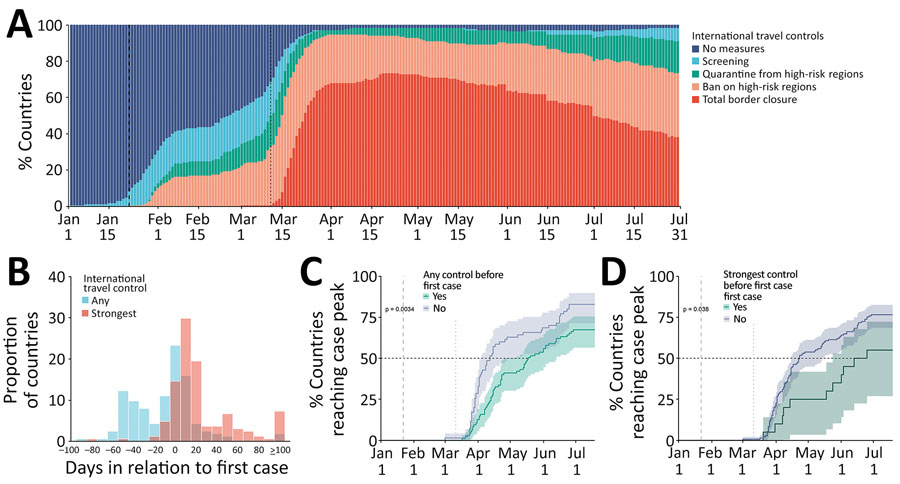Volume 28, Number 1—January 2022
Research Letter
Effectiveness of International Travel Controls for Delaying Local Outbreaks of COVID-19
Figure

Figure. Association between international travel controls and local coronavirus disease (COVID-19) outbreaks in 165 countries, January 1–July 31, 2020. A) Temporal distribution of the international travel controls enacted by the studied countries. Data from (7). B) Distribution of the time between a country’s first COVID-19 case and its enactment of any or of the strongest international travel controls. C, D) Probability of reaching first local peak of COVID-19 cases by the time of implementing any (C) or the strongest (D) international travel controls, estimated by using the Kaplan-Meier survival function. Vertical dashed lines in panels B, C, and D indicate the date that Wuhan, China, underwent lockdown; vertical dotted lines indicate the date that the pandemic was declared.
References
- World Health Organization. Statement on the second meeting of the International Health Regulations (2005) Emergency Committee regarding the outbreak of novel coronavirus (2019-nCoV) [cited 2021 Aug 2]. https://www.who.int/news/item/30-01-2020-statement-on-the-second-meeting-of-the-international-health-regulations-(2005)-emergency-committee-regarding-the-outbreak-of-novel-coronavirus-(2019-ncov)
- Cowling BJ, Lau LLH, Wu P, Wong HWC, Fang VJ, Riley S, et al. Entry screening to delay local transmission of 2009 pandemic influenza A (H1N1). BMC Infect Dis. 2010;10:82. DOIPubMedGoogle Scholar
- Ryu S, Gao H, Wong JY, Shiu EYC, Xiao J, Fong MW, et al. Nonpharmaceutical measures for pandemic influenza in nonhealthcare settings–international travel-related measures. Emerg Infect Dis. 2020;26:961–6. DOIPubMedGoogle Scholar
- Dong E, Du H, Gardner L. An interactive web-based dashboard to track COVID-19 in real time. Lancet Infect Dis. 2020;20:533–4. DOIPubMedGoogle Scholar
- Hale T, Angrist N, Goldszmidt R, Kira B, Petherick A, Phillips T, et al. A global panel database of pandemic policies (Oxford COVID-19 Government Response Tracker) [cited 2021 Aug 2]. https://www.nature.com/articles/s41562-021-01079-8
- Our World in Data. Policy responses to the coronavirus pandemic [cited 2021 Aug 2]. https://ourworldindata.org/policy-responses-covid